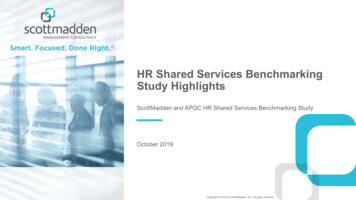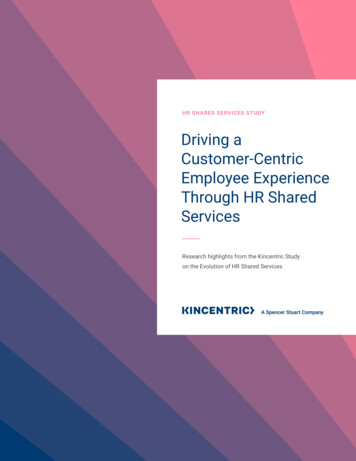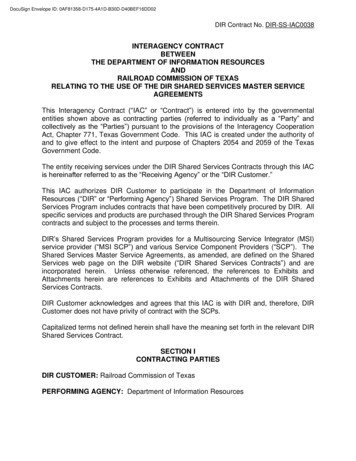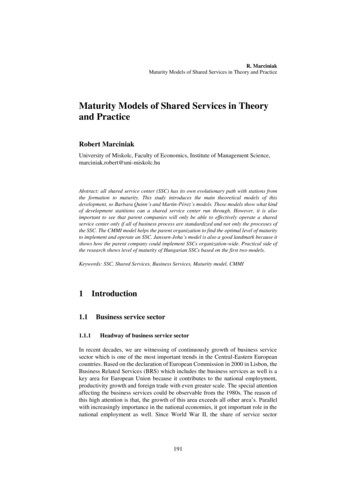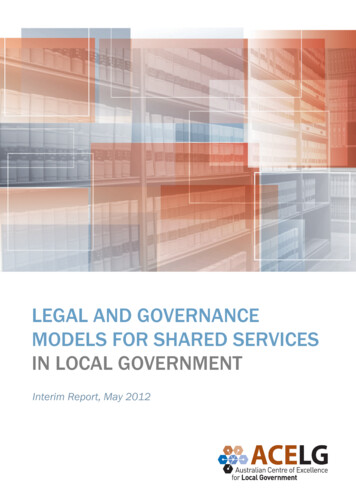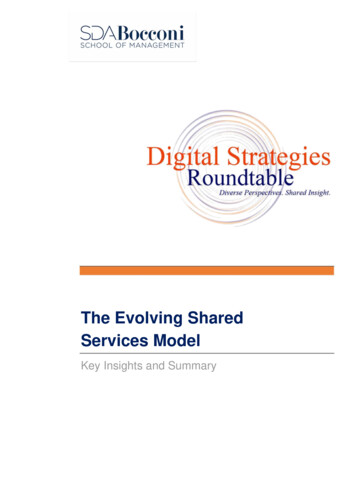
Transcription
The Evolving SharedServices ModelKey Insights and Summary
The Evolving Shared Services ModelDigital Strategies RoundtableAn executive roundtable series of theSDA Bocconi School of Management at the Università BocconiThe idea of business services shared within a company has been in vogue for some years. The operationalphilosophy behind it has evolved from disparate support services to consolidated corporate functions to a vision oftruly global shared business services. This roundtable addresses how far different enterprises have moved alongthis shared services path, the results they have achieved, and the lessons learned along the way. Held 18 monthsafter the onset of the COVID-19 pandemic, the discussion also considers how shared services and increasedautomation have unexpectedly combined with remote working to re-shape the future of the workplace.CIOs and their executive colleagues running shared service centers from Airline Reporting Corporation, theAmerican Bureau of Shipping, Angelini Holding, Chevron, Conagra Brands, Eaton Corp., Swarovski, Tenaris, andTetra Pak convened by web conference to discuss the past, present, and future of shared services, and how theyintersect with and impact broader digital transformation of the enterprise.Key Insights Discussed in this Article:1.Contrary to common belief, the primary catalyst for shared services is process quality,not labor cost arbitrage. Companies start shared services to standardize fragmentedprocesses, centralize duplicate operations, and improve results; labor cost savings are asecondary — though welcome — benefit . .pages 2-3, 6-82.It’s important not to tackle everything at once. Solving for the 80 percent of processesand activities that can be standardized now, and addressing the 20 percent of exceptionslater, is a key design principle for shared services. It’s also important not to standardize(or outsource) a bad process in the name of efficiency. .pages 3-4, 6-8, 123.Shared services create inherent tension among agility, flexibility, and enterpriseresilience. Standardization and excellence in core areas give enterprises the ability toexperiment in other areas, but operating units can remain reluctant to give up controland governance over core processes. . pages 4-5, 8, 13-154.Talent is a key dynamic in managing shared services. Shared service operations havebecome too important to be led by the second string. At the same time, one of the keybenefits of shared services is to release talent to move their focus to other critical areasof corporate growth . .pages 9, 11-125.Shared services are expanding from standardizing execution of repetitive tasks intoproviding business insights and enabling corporate centers of excellence. Centralizeddata for reporting and analytics is combining with automation and AI to deliver businessintelligence that gives shared services increasingly strategic roles, and could even helpdrive P&L expansion. pages 3, 10-11, 16-19 2021 SDA Bocconi School of Management. This overview was written by Hans Brechbühl, Associate Professor of Practice atSDA Bocconi & Director, Digital Strategies Roundtable, and Stephen Plume, Executive Fellow, Digital Strategies Roundtable. TheDigital Strategies Roundtable publication series is edited by Hans Brechbühl.
The Journeys to DateEnterprise-scale shared service center operations date back to at least the mid-1990s. Typicallythey started by centralizing IT and/or service functions into a single location, therebyeliminating duplicate operations (and often duplicate staff) dispersed across the geographicscope of the company’s operations. Often located in low-labor-cost countries, shared servicecenters have been characterized — admiringly or disparagingly, depending on the speaker’sviewpoint — as little more than labor-arbitrage financial plays. From that perspective, sharedservices may have run their course, as the wage gap shrinks and other costs of doing businessincrease in many countries around the world. However, insights from the Digital StrategiesRoundtable suggest that this “common wisdom” may be wrong on several dimensions, and thatthe truth about both the past and the future of shared services is considerably more nuancedand potentially more powerful.Roundtable Director Hans Brechbühl started the discussion by asking each member company totalk about its current shared service operation, why it started, and the major steps along thejourney to its current form.Conagra: In Search of (Process) ExcellenceTracy Schaefer, Vice President of Global Business Services for Conagra Brands, spoke first:Our implementation of SAP was a key contributor to our first move into sharedservices, about 15 years ago. The goal was common systems and common processesfor our organization, in a single location. As we learned more about business processoutsourcing, we realized there were additional plays in labor arbitrage, and so wemoved to outsourcing as a cost play just over five years ago. Since then, we havelearned a lot about transformation and modernization, the expectations of our BPOpartner, and hence the skill set that we need internally in order to push automation.So we created an automation Center of Excellence (“CoE”) within our shared servicescenter to support our BPO, and now that’s turned into a skill set that the entireenterprise can tap into. That ability to automate opens the door to increasing thenumber of services that we provide. We look to provide services not only at a cheapercost, but in a more modern way, in a more measured way, and in a way that canprovide value and business growth back to the enterprise.Our Global Business Services Group today has all order-to-cash functions, as well asaccounts payable, T&E, expense management, and data management. Within the lastyear we’ve also incorporated Consumer Affairs, which used to be in our marketingorganization. It was a group that didn’t have the time or flexibility to devote tomodernization. So we brought it in, changed outsourcing providers, and gotperformance metrics rolling. We’ve been able to expand on chat bots and other waysto interact with our customers, while providing value back to the business aroundanalytics and quality.“We’re years into the shared services journey, and it has never been about savings,” amplifiedMindy Simon, Conagra’s Chief Business Global Business and Information Officer. “From the very2
beginning the goal has been to standardize processes to achieve process excellence. Savingshave come because of that excellence. We’ve also created organizational nimbleness, andwe’ve achieved everything we’ve intended along the way.”Tenaris: From Arbitrage to TransformationFernando Marossero, Director of Tenaris’ Shared Service Center, picked up the thread:Our journey in shared services started in 2012, when we created entities in Romaniaand Mexico City. Their functions started with accounts payable and the corporate sideof human resources, including payroll. From 2013 to 2015 we brought in activitiesrelated to supply chain: customer invoicing, inventory management for remotelocations, certification of logistics services. There was a lot of focus on labor arbitragefrom particular countries, and on centralization of activities. Management of theshared services lay in one legal entity, but was executed by the different functionalorganizations.In 2016 we unified the leadership of all our shared services and became amultifunctional service organization operating in 30 countries. We worked ontransformation in several areas, including giving a common sense of identity to theteams that had come from different functional organizations, and in 2017 we launchedour Center of Excellence. The CoE initially focused on RPA capability, but it has becomethe heart of identifying and incorporating technologies for particular functions, such ascase management, quality assurance, management controls, chat bots — it givessupport for whatever operation the business needs to perform.At the same time our shared services have expanded their global reach withstandardization and application of technology. This has improved the quality of ouroperations and helped us achieve a different level of excellence, and we’ve received alot of efficiency along the way from the standardization. And now our CoE is joiningwith IT to accelerate digitalization across the company.“When we started, it was 100% about labor arbitrage,” clarified Alejandro Lammertyn, Tenaris’Chief Digital and Strategy Officer.The shared services initiative was managed by a consultant who didn’t look intoprocess improvement, but only looked at the nasty work that the functional areasdidn’t want anymore. The first step was to put that work somewhere else at lowercost. It took a long time to convert this into something that made sense in terms ofimproving and automating processes so that we don’t really need people anymore torun these activities. This is why the skills in the shared services group are so importantto expand to the entire organization.“Our goals now include accelerating digitalization and incorporating RPAs to create moreefficiency,” finished Osvaldo Rosetti, Tenaris’ Project Director for Process Improvement. “Andof course, to continue to standardize old processes and introduce new and better ones.”3
Swarovski: Classic Lift-and-Shift“Five years ago, we had full-fledged F&A organizations in every country, with heterogenousprocesses,” began Max Braun, CIO of Swarovski. “Our goal was to standardize and simplifythese processes. Our approach was to bundle as many of them as possible into hub-and-spokeorganizations, since it’s so much easier to simplify processes under central responsibility thanthrough 30 independent F&A managers. So we stood up shared services centers in Poland,Costa Rica, and Malaysia. We definitely wanted to benefit from labor arbitrage, but even more,to gain momentum with standardization of processes, simplification, and automation. So firstwe lifted and shifted the solutions to new locations, and now we’re starting withstandardization of processes.”Tetra Pak: A BPO HybridMark Meyer, Global IM at Tetra Pak, presented a very different shared services origin story:When we embarked on our global process journey in 2000, it was not a labor arbitragemovement. Rather, it was about globalization of processes and process efficiency. Thevery first thing we understood was, to deploy a global system we had to have a sharedservice center to support delivery of that system, and before we could have sharedservices delivered to the business side, we had to deliver shared IT services.“So, we started by centralizing IT functions in several locations,” continued Christian Moraldo,Tetra Pak’s Vice President — Group Financial Control and Finance Operations.After that, the main reason for the shared service centers was because everything wasfragmented. For example, we had accounting everywhere in the world. Our idea wasto improve business partnering, reduce costs, improve quality, and increase the levelof assurance in our controls. Along the way, we transferred everything to a BPOprovider, expecting that magic would somehow solve everything. That didn’t work out,so we brought some of it back.Today, we have a hybrid model. In-house, we have three functional shared servicecenters for finance, HR, and recently supply management. We capture all the value wecan by sharing among the different functions. For Finance, we have 5 hubs and wehave outsourced all activities that are not strategic, that do not require strong businessknowledge. We’ve also left things that require local knowledge in specific countries,but not a lot — 80 percent of activities have been centralized in the hubs. The hybridmodel isn’t easy to build, but we receive a lot of value from it.There was cultural resistance. At first the change was very much driven from the topdown. But we learned quickly that if you don’t engage the key stakeholders who willbe part of the transformation in the design and planning, things will become muchmore difficult.“So you outsourced to a BPO, and then brought it back in-house?” asked Allen Flickinger,Chevron’s General Manager, Shared Financial Services.4
“Yes. It turns out to be important how you approach the relationship with your BPO provider,”Moraldo replied.Are they just a supplier and you are just a customer, or is there a partnership mindset?Many companies & people believe that by transferring the mess to the BPO,everything would be solved, and so they became very skeptical of BPO in general whenthat didn’t happen. But the reality is, we share the responsibility. Most of the timewhen something doesn’t work, it’s not the BPO’s fault.This all takes time, and it’s not easy. We’ve been working with our BPO provider for 15years now, and we’ve learned a lot from them, even on internal processes that weoriginally outsourced to them. It’s about the mindset, the approach, and about sharingin an open and transparent way.“It was interesting to watch the evolution in the mindset of the main leaders,” commented JanProvoost, Tetra Pak’s Vice President — Group Financial Control and Finance Operations. “Afterour initial setbacks, many were completely resistant to BPO providers, and even a few to sharedservice centers. Their change of mindset as we made these changes was a positive surprise inthe journey.”Angelini Holding: Balancing Structure with Flexibility“20 years ago, our IT situation was really fragmented, so IT became the foundation for ourshared services today,” recalled Marco Lanza, Chief Information and Digitalization Officer forAngelini Holdings. “Now they include HR, F&A, general counsel, and institutional affairs. Wealso have a big joint venture, so our shared services are a mixture of centralized and federated.For all these shared services, and for IT in particular, we have service level agreements with thebusinesses, and we charge-back to every business.”“What’s surprising is how shared services have become the basis for our culturaltransformation,” remarked Giuseppe Tino, Angelini’s Group Head, Organization and ChangeManagement.We deal with many operating companies, spread across different industries, and so wetry to standardize both their requests and our responses, using process on the onehand and technology on the other. Discussions with business leaders with verydifferent needs in various markets and industries constitute a daily challenge. We’vehad to re-think how we deliver our services and how to globalize processes. Despitebeing very structured, we have recognized quite a need for flexibility in order to servethe operating companies.American Bureau of Shipping: Structure from Chaos“Like many of you, IT systems have driven our shared services approach over the years, alongwith the centralization of support,” affirmed Maria O’Neill, CIO of ABS.It started with our Oracle ERP system, which was implemented as a single globalinstance. That’s important because we go on-board vessels for inspections. These shipsmove all over the world, so it’s important that we have access to the same system —5
every time, in every place. That said, 10 years ago at the office level, every locationaround the world was buying their own computers and running their own desktopimages. It was a mess: we had all kinds of collision problems with Office, with email, etcetera.So we cleaned everything up. We signed an enterprise agreement with Microsoft. All ITpeople around the world now report to the CIO, so we can do things consistently andglobally. IT has become the model for other functions to become more centralized. Wealso pulled back all application support, desktop support, and help desk from anoutsourcer, and stood up our own captive center in Pune. The quality of our supporthas improved tremendously, and it has resulted in a lot of savings.“Finance has also had success with shared services, but there have been pitfalls along the way,”cautioned Laura Fulton, ABS’ Vice President Finance.In finance we’re a hybrid. We outsource accounts payable and accounts receivable;regional centers do collections; and language or regulatory requirements mandate thatsome of our regional centers do shared services as well. When we did the big lift-andshift to our BPO provider in India, we shifted a conglomeration of different ways ofdoing things, and we expected they would help us to standardize those processes.Some of that has happened, and some of it hasn’t. One mistake was to keep people asprocess owners, even though they weren’t really process people. They were great doers of the process, but they weren’t the ones to sit and think through how to improveit, how to standardize it, how to centralize it. We’ve struggled with that over the lastfew years.“We weren’t getting the automation we expected from our BPO partners either,” Schaefervolunteered. “So we started a grass-roots effort to build automations within our shared servicecenter, and it skyrocketed from there. Now everybody comes to our automation CoE for helpon their teams. We got to here without thinking that this was going to be an enterprise-wideservice, so it’s all just a gift to them.”“How do you mix standardization and local adaptation?” asked Andrea Dossi, AssociateProfessor of Management Control Systems at the SDA Bocconi School for Management. “Thereare the advantages to the shared services model, but local contexts can be so different.”“We have standardized and centralized where we can,” Fulton answered. “But we still haveregional service centers, particularly in China and Greece, where the cultural aspects areimportant, and language in particular is very important. We follow the standardized processesas much as we can, but if the cost is cheaper to keep a person locally, we do, even if they’repart of a shared services function, working completely alone in a country. Their physicallocation may be different, but that’s worked out well in the virtual environment this year.”Airline Reporting Corporation: Who Goes First?“We’ve been trying to get rid of the redundancies from different segments using different toolsto do exactly the same thing,” explained Heather Unger, ARC’s Director of Human Resources.6
“Most functions are now within the shared services model. Our biggest goals were cost savingsand process efficiencies, and we’ve come so far. Now, prioritization has become a challenge.When resources are spread across shared services and matrixed back to the product groups,how do you figure out which group has priority to have their needs met?”“We’re using technology to evolve our thinking, as we transform from a nonprofit type oforganization to for-profit,” added Dickie Oliver, ARC’s CIO. “We are focused on standardizationand automation. Our shared services have been built on legacy platforms. Since we completelychanged our tech stack, we now have the chance to automate business processes to eliminatemanual inefficiencies.”Chevron: No Regrets“25 years ago, we took a bunch of haphazard finance groups from round the US and centralizedthem in California,” Flickinger began.Within a couple of years, we started up in Manila, realizing the labor arbitragebenefits. Then we started a second center in Buenos Aires. We still have some sharedservice activity in the US, though that is declining. The centers have finance, IT, HR, andsupply chain, including procurement. We also have a big customer service contingentin Manila. Everything transactional takes place inside the service centers. Moredetailed analysis and decision support remains in the business units.All these groups are co-located, but still managed largely by the functions. In eachlocation we have a senior committee made up of the leaders of each function thatmanages all local decisions, and they have quite a bit of autonomy. At the top, we havea board that looks after all our shared services activities, as well as more strategicissues around capabilities and staffing and risk management.Our biggest surprise is that we’ve never had a regret for anything that we’ve moved tothese service centers. Every time we lift-and-shift, we find that if we have sevenpositions to migrate, we can design only five into the new structure, withoutconsequence. So we get efficiencies right off the bat. And once we move past an initialburn-in period, the centers provide a higher-quality, well-oiled, and reliable workproduct. The teams are strong, they’re hungry, they’re curious, and they’ve been ableto handle everything we’ve thrown at them. That may mean we should be moreaggressive about what we move into the centers.“Even as we had success, we did fall into a trap though,” countered Bill Braun, Chevron’s CIO.We started to move more and more IT functions into the centers, trying to find thelimit of capabilities of these teams, and we lost some discipline around what should gothere. Processes no one wanted got put there, and the centers turned a bit into islandsof misfit toys. That wasn’t a good model, and so we’ve had to reel back a bit, and bemore deliberate about what goes into shared services. We came too close to letting itbecome a collective of everything.7
Eaton: The Journey Never Ends“Eaton’s been doing shared services for almost 25 years,” commented Ray Huber, Eaton’s SVPof IT.We started in the mid-‘90s with finance, and we have expanded to IT, supply chain andHR. The original objective was two-fold: One was that we were making lots ofacquisitions — 70 or more over 20 years — and we wanted to move all thesebusinesses onto a common financial platform. The second was to standardizeprocesses, at least regionally, to take cost out of the transactions. So we created one inthe US, one in EMEA, and eventually one in Pune for Asia Pacific. Although thesestarted as regional centers, in the last several years we’ve tried to move to more globalprocesses and standards. Our other current initiative is to increase automation, andwe’ve implemented bots to manage a lot of the transactions that occur in the servicecenters.“Did you achieve your goals?” asked moderator John Gallant, Senior Content Strategist ofLedgewood Media.“Our goals have changed over the years,” explained Dan Hopgood, Eaton’s SVP and Controller.We started out just to centralize regional activities so we could standardize. Then westarted to go down the low-cost/labor arbitrage path, while also moving towardsglobal standardization. Now we have three global process leaders who manage acrossall our centers. That’s led to enough additional standardization that now we focus onautomation. Robotics is a piece of that, and we have 15-16 bots today in finance alone,and more in other areas.So this clearly gives us cost efficiencies. Every year we’ve been also able to contributemillions, cumulatively tens of millions of dollars, in addition to offsetting inflation. Butthe real benefits are in the ability through standardization to provide better controland oversight. We’re also starting to make inroads in our ability to crunch data andprovide insights, around issues like supply chain optimization, or deciding how toallocate our working capital.The next stage of the journey that we are thinking about is the global business servicesapproach. We struggle with that idea. We manage our shared services independently— finance, HR, procurement, and IT. But we collaborate closely, and we are alreadyleveraging scale by co-locating these operations. Pune is our largest center in theworld, and finance is right there with IT, HR, and customer service as well. So, we arewondering, “What additional benefits would come from a global business servicemodel?”8
The Road to Returns“There seems to be a common evolution from transactional efficiency to more strategic sharedservice center activities,” Dossi observed. “Sometimes ‘strategic’ means more intangible value,and intangible value is not easy to measure. Are there any problems in measuring theperformance of the shared service centers, as they move more towards automation?”“We are wrestling with that question,” Flickinger admitted. “We’re good at building bots andautomating, but we’re not seeing the headcount reductions on the other end. People are moreinclined to re-purpose individuals than to actually diminish headcount.”“When we started our automation team at Chevron, I challenged the leaders to see how manyjobs they could remove each year,” Braun recalled. “They had very little interest in displacingtheir colleagues’ positions. After we made it clear that those people would be re-assigned toother work, then it was OK. But the resistance was so deep we were not going to be successfulthe way we had originally framed it.”“Our employees find it easier to support a change to shared services if we make sure to helpthem understand that as we eliminate processes, and possibly jobs, we’re giving them a path tosomething new,” Unger affirmed. “That path could be a completely different skill set, so webuild in training time to help them learn what else might be available.”“Our automation efforts now finally have enough leverage that at last people are saying they’renot going to backfill roles,” Simon added. “They’re going to take the cost out. But it’s takenthree years to build that kind of muscle.”“That hits home,” Schaefer said. “Building RPA for the enterprise is now costing a materialamount. How do we make sure the ROI is being realized? One place we’ve started is an RPAdashboard. Every time we build an automation, the function receiving the benefit has to alignto the ROI: upfront, we’re agreeing the value that we’re going to drive from the automation.”“Eaton has established dashboards and tracking right up front,” Hopgood volunteered. “Webuild the savings targets right into our forecast and our planning, and we track our headcountversus service ratios. We average around 15 percent savings on automation projects, and aswe’ve added services and activities, we’re able to hold headcount flat and just absorb thetechnology. The follow-on benefit is that we use the dashboards to further improve andstreamline our processes. Those are additional soft savings that were not even in our businesscases.”“We are just at the beginning of strategic business control types of activity,” Moraldo reflected.“We believe we can leverage more capabilities, but the growth is gradual. The challenge is toensure that you have some repetitive tasks to work on, for example, reports. We now have acenter of business information management to help build standard reports and dashboards, sothe businesses can shift the nature of the work they focus on: more time with the managingdirectors, more time with customers, more time collecting money, et cetera.”9
“It’s very important to help people to understand the benefits beyond labor arbitrage,”Marossero summarized. “Not only are processes cheaper in the shared service center, butwe’ve also reduced lead time on submitting customer invoices from 30 days to 2 days, andwe’ve reduced duplicate payments from A/P because we incorporated technology that does inreal-time what an auditor used to do once a year. There are a lot of KPIs that help remove theidea of labor arbitrage and reveal the real advantages of the shared services concept.”“It really makes sense to centralize reporting and analytics,” Hopgood agreed. “Whenorganizations need different sets of data analyzed, shared services is the team that has it all inone place. We’ve created a CoE for reporting. Several times now businesses have struggled forweeks to pull something together. Then they ask us, and we do it in half a day.”“Does anyone believe that shared services are a competitive advantage, or could become asource of competitive advantage?” Gallant asked.“A good shared services organization has become table stakes,” Flickinger suggested. “It letsyou survive. And the converse is true, if you don’t have good shared services, you’re at acompetitive disadvantage.”“The co-location that several of you have described makes intuitive sense, but what are theactual benefits?” Brechbühl asked. “Can you exchange people between one function andanother, or does it enable process handoffs that couldn’t otherwise happen?”“It’s really just the benefit of scale,” Hopgood answered. “There’s not a lot of talent-sharing,because people tend to be expert in specific fields. We have more than 5,000 people in Pune,with the facility managed by one team: all the infrastructure, all the support services. Iteliminates the duplication that comes from multiple facilities.”“Tetra Pak also has a huge site near Pune,” Meyer stated. “It’s not just a shared service center:it’s a factory, it’s engineering operations. And we don’t just run pure labor arbitrage there,though we do enjoy the benefits of operating out of India. We get lots of benefit from having acampus environment, where there are shared learning capabilities because of the movement ofpeople.”Talent Attracts Talent and Needs Career Paths“That was one of the main lessons when we built our first shared service center for Tetra Pak inManchester,” Moraldo added. “Manchester was a completely greenfield location, and thepeople were disconnected from the rest of the company. So, one of our guiding principlesbecame, No new locations in greenfields! Now we go to ‘brownfields,’ where we already have afactory or a big operation, so that we can stimulate career development, and people are moreconnected to the business.”“Not a lot of people say they dream of working in a shared service center,” Schaeferacknowledged. “Shared services haven’t typically been a career destination. We’ve had todevelop the roles that we have, how we recruit talent, and how we talk to our people about10
career growth and development. Talking more strategically about the roles in terms of thetransformation they can help provide has been key for us in t
The Evolving Shared Services Model Digital Strategies Roundtable . shared services lay in one legal entity, but was executed by the different functional . In 2016 we unified the leadership of all our shared services and became a multifunctional service organization operating in 30 countries. We worked on



